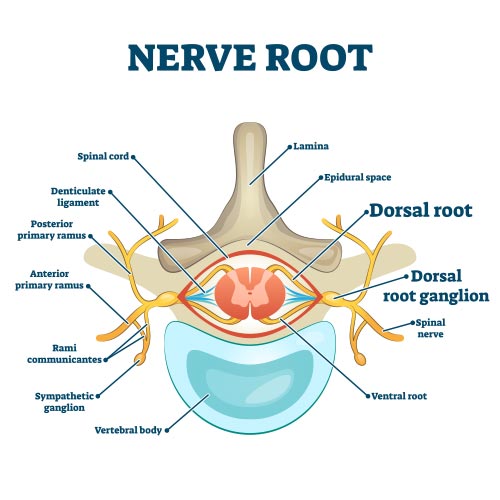
Dorsal Root Ganglion Implant
Dorsal root ganglion (DRG) therapy involves technology similar to that used in spinal cord stimulation. However, in DRG therapy, the mild electrical signals target specific structures on the spinal column (areas of nerves known as a dorsal root ganglia) that are involved in a person’s localized pain. The system’s signals intercept the body’s pain signals before they reach the brain. The California Pain Doctors are highly specialized in treating CRPS patients with DRG Stimulation. CRPS (also called Complex Regional Pain Syndrome) is described as pain concentrated in your foot, knee, hip or groin following an injury or surgical procedure, and that grows worse over time.
How DRG therapy works
DRG therapy works by stimulating dorsal root ganglia (DRGs). These are structures along the spinal column made up of densely populated sensory nerves, and they act like traffic lights, regulating signals and sensations that travel through nerve fibers along the spinal column to the brain.
Because the spinal column has a number of different DRGs, each of which is associated with different areas of the body, DRG therapy can target the DRG that is associated with the specific area of the body where a patient experiences pain. In this way, DRG therapy has the unique ability to help manage pain in targeted parts of the body where pain occurs, and is especially helpful for patients like you and those who live with isolated chronic pain in the lower parts of the body.
If your doctor decides that DRG therapy is right for you, you will receive a DRG therapy system. This system is made up of parts that are designed to work together to help you manage your pain:
- Generator: A small device that sends out mild electrical pulses and that contains a battery. This is implanted in your body.
- Leads: Thin insulated wires that carry the electrical pulses from the generator to your dorsal root ganglia. These are placed in your body in the area of the DRG.
- Patient controller: A handheld “remote control” that allows you to adjust the strength and location of stimulation or even turn stimulation off.
DRG stimulation is offered exclusively by St. Jude Medical and clinical studies show that it delivers superior pain relief for people suffering from CRPS. The California Pain Doctors work with St. Jude Medical to offer both trial and permanent DRG therapy systems.
DRG therapy may be an option if you have:
- Chronic pain that has lasted six months or more
- Isolated chronic pain in a lower part of the body, such as the foot, knee, hip or groin, following an injury or surgical procedure
- Little or no relief from traditional neurostimulation, surgery, pain medications, nerve blocks or other pain management therapies
While neurostimulation therapies such as DRG therapy help most patients receive at least some reduction in pain, not everyone responds in the same way. Complications may include painful stimulation, loss of pain relief and certain surgical risks (e.g., paralysis). Talk to your doctor to see if DRG therapy may be right for you. Be sure to discuss the risks and benefits of neurostimulation with your doctor. Learn more about dorsal root ganglion therapy and the type of pain it helps manage.
Contact Us
To schedule an appointment or to find out more information, contact Spanish Hills Interventional Pain Specialists today.
Call: 1-805-484-8558
or
